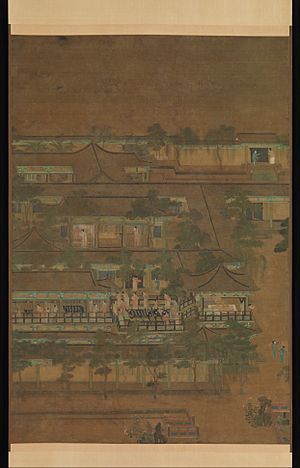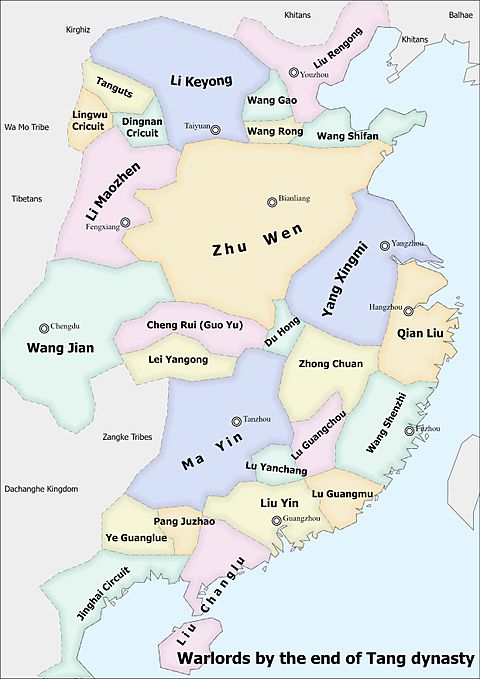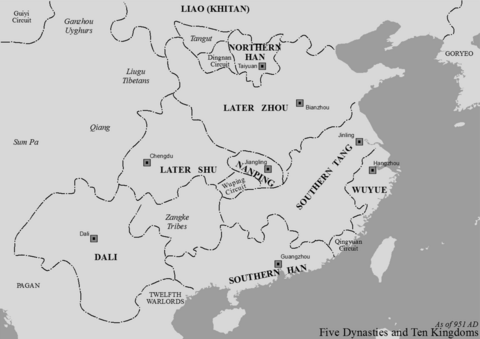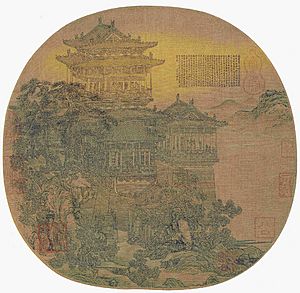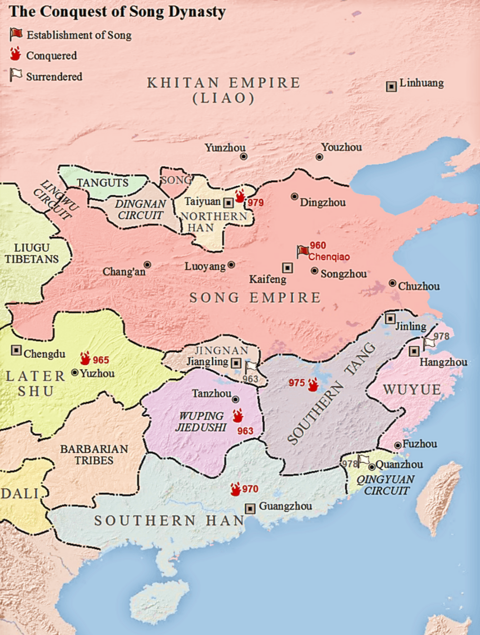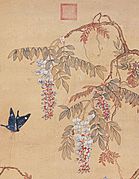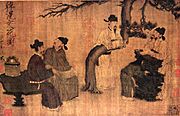Five Dynasties and Ten Kingdoms period facts for kids
Quick facts for kids Five Dynasties and Ten Kingdoms |
|||||||||||||||
|---|---|---|---|---|---|---|---|---|---|---|---|---|---|---|---|
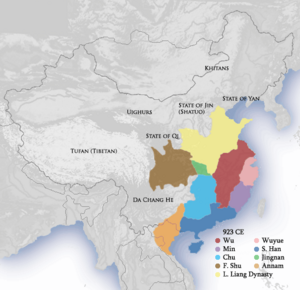
The Later Liang (yellow) and contemporary kingdoms
|
|||||||||||||||
| Traditional Chinese | 五代十國 | ||||||||||||||
| Simplified Chinese | 五代十国 | ||||||||||||||
|
|||||||||||||||
The Five Dynasties and Ten Kingdoms period (Chinese: 五代十國) was a time of big changes and many separate states in China. It lasted from 907 to 979 AD. During this time, five different ruling families, called dynasties, quickly took power one after another in the central part of China.
At the same time, more than ten other states, known as the Ten Kingdoms, were set up in other areas. Most of these were in southern China. This was a long period when China was divided into many different political groups.
This era usually starts with the end of the Tang dynasty in 907. It ends when the Song dynasty was founded in 960. Over the next 19 years, the Song dynasty slowly took over the remaining states in southern China. However, the Liao dynasty still ruled in northern China. Later, the Western Xia kingdom was also formed in China's northwest.
Many states were already independent before 907. This happened because the Tang dynasty's control over its officials became weak. After the Tang dynasty fell, several powerful military leaders, called warlords, in central China declared themselves emperors. For about 70 years, there was almost constant fighting between these new kingdoms. They often formed alliances with each other. Their main goal was to control central China and become the new rulers after the Tang.
The last state from this period was Northern Han. The Song dynasty conquered it in 979. For many centuries after, the Song dynasty controlled much of southern China. But they shared China with the Liao dynasty, Jin dynasty, and other groups in the north. Eventually, all of China was reunited under the Yuan dynasty.
Contents
What Led to This Time?
Towards the end of the Tang dynasty, the government gave more power to jiedushi. These were regional military governors. Big rebellions, like the An Lushan (755–763) and Huang Chao rebellions, made the central government weak. By the early 900s, these jiedushi were basically independent.
In the last decades of the Tang dynasty, the central government didn't even appoint them anymore. Instead, their positions became like family inheritances. They passed from father to son or from a leader to their chosen follower. These governors had their own armies, which were as strong as the emperor's armies. They also gathered a lot of wealth.
Historians often see this period in three parts. The first part (880–910) was very chaotic. Warlords fought each other, each controlling small areas. The second part (910–950) saw these warlords become more stable. They gained enough power to start their own dynasties. The third part (950–979) was when China was forcefully reunited. This was done by the Later Zhou and then the Song dynasty.
Southern China was divided into several independent kingdoms. It was more stable than the North, where rulers changed often. Because of this, the Southern kingdoms could focus on trade and building projects. This helped set the stage for a big economic boom during the Song dynasty. Many people also moved from the North to the South during this time.
The North's Story
In the northern parts of China, some areas had a lot of freedom from the central government. Their local military leaders controlled everything. They didn't send tax money to the capital, and their leadership positions were passed down in families. These areas sometimes fought the central government or each other.
Many important people in China after the Tang dynasty came from this northern region. This included future emperors of the Song dynasty. The ruling families of the Five Dynasties and early Song dynasty often came from military leaders in northern China. These families became powerful as the central government weakened.
The term "Five Dynasties" was created by historians from the Song dynasty. It shows their belief that the rulers in Kaifeng (the capital) had the right to rule all of China. The first of the Five Dynasties was started by Zhu Wen. He was a rebel who became a warlord and eventually ended the Tang dynasty. The other Five Dynasties and the Song dynasty all came from a military group led by Shatuo Turks. Their leaders often took power from each other.
The rulers of the Five Dynasties, even though they called themselves emperors, sometimes treated each other as equals. This was because no single ruler was strong enough to control everyone. After China was reunited by the Song dynasty, they tried to change this idea of "sharing power."
The South's Story
The Southern kingdoms generally had more stable and effective governments during this time. Even the rulers of these Southern states were mostly military leaders from the North. Their main officers and best soldiers also came from the North. This was because most of the Tang army was based in the North.
The founders of these Southern kingdoms often came from humble backgrounds. They rose to power because of their strong military skills. Later scholars sometimes called them "bandits." However, once they became rulers, they worked hard to show themselves as leaders who supported culture and economic growth. Many invited former Tang officials to help them run their states.
The economies in each of the southern regions grew a lot in the late Tang period. Areas like Guangdong and Fujian had important port cities for trading goods. The middle Yangtze River and Sichuan were known for producing tea and porcelain. The Yangtze delta was a place with very high farm production. These regions depended on each other for trade.
The Tang dynasty didn't focus much on developing the South. This allowed the South to try new things without strict government control. Northern officials often didn't want to work in the South during the Tang period. So, southerners were hired for local jobs. These southern officials became the main administrators of the Ten Kingdoms. Later, they became very important in the government during the Song dynasty.
Important Military Leaders
Here are some of the important military leaders (jiedushi) during this time:
North China
- Wang Rong in Zhenzhou (modern Zhengding County, Hebei province)
- Wang Chuzhi in Dingzhou (modern Dingzhou, Hebei)
- Li Keyong and Li Cunxu in Taiyuan (modern Taiyuan, Shanxi), who started the Later Tang
- Liu Rengong and Liu Shouguang in Youzhou (modern Beijing), who started Yan
- Li Maozhen in Fengxiang (modern Fengxiang County, Shaanxi province), who started Qi
- Luo Shaowei in Weibo (modern Daming County, Hebei province)
- Li Sigong in Dingnan circuit, who started Western Xia
- Zhang Yichao in Guiyi
- Zhu Wen in Bianzhou (modern Kaifeng, Henan), who started the Later Liang
South China
- Qian Liu in Hangzhou (modern Hangzhou, Zhejiang), who started Wuyue
- Ma Yin in Tanzhou (modern Changsha, Hunan), who started Chu
- Wang Shenzhi in Fuzhou (modern Fuzhou, Fujian), who started Min
- Liu Yin in Guangzhou (modern Guangzhou, Guangdong), who started Southern Han
- Wang Jian in Chengdu (modern Chengdu, Sichuan), who started Former Shu
- Yang Xingmi in Yangzhou (modern Yangzhou, Jiangsu), who started Wu
- Gao Jixing in Jingzhou, who started Jingnan
The Five Dynasties
Later Liang (907–923)
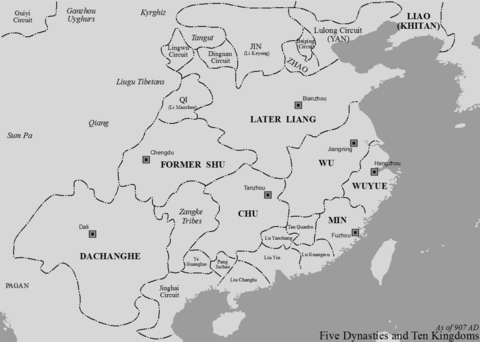
The warlord Zhu Wen was once part of a rebel army during the Tang dynasty. He played a key role in stopping the Huang Chao Rebellion. For this, he was given the title of Xuanwu Jiedushi. In a few years, he gained more power by defeating his neighbors. He also forced the emperor to move the capital to Luoyang, which was in his area.
In 904, he had Emperor Zhaozong of Tang killed. He then made Zhaozong's 13-year-old son, Emperor Ai of Tang, a puppet ruler. Three years later, he made the young emperor give up his throne to him. Zhu Wen then declared himself emperor, starting the Later Liang dynasty.
Later Tang (923–937)
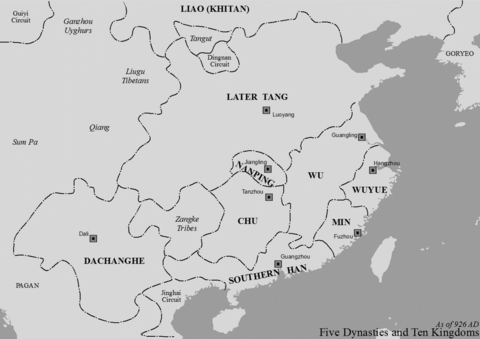
Towards the end of the Tang dynasty, rival warlords declared independence. Li Keyong was a military governor in Shanxi. His son, Li Cunxu, fought hard to conquer northern China. Li Cunxu defeated a rival in 915 and declared himself emperor in 923. Within a few months, he defeated the Later Liang dynasty.
This began the Shatuo Later Tang dynasty. It was the first of several dynasties founded by non-Chinese groups. After uniting much of northern China, Li Cunxu also conquered the Former Shu kingdom in Sichuan in 925.
Later Jin (936–943)
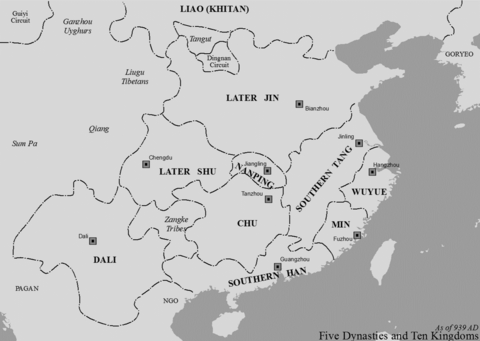
The Later Tang had a few calm years, but then problems started. In 934, Sichuan became independent again. In 936, Shi Jingtang rebelled against the Later Tang emperor. Shi Jingtang was a Shatuo military governor from Taiyuan. He got help from the Khitan-led Liao dynasty for his rebellion.
In return for their help, Shi Jingtang promised to pay them every year. He also gave them a large area of land called the Sixteen Prefectures. His rebellion succeeded, and Shi Jingtang became emperor in the same year.
Soon after the Later Jin was founded, the Liao dynasty started to see the emperor as their puppet ruler. In 943, the Khitans declared war. Within three years, they captured the capital, Kaifeng. This ended the Later Jin dynasty. But the Khitans couldn't control these large areas of China. They left early the next year.
Later Han (947–951)
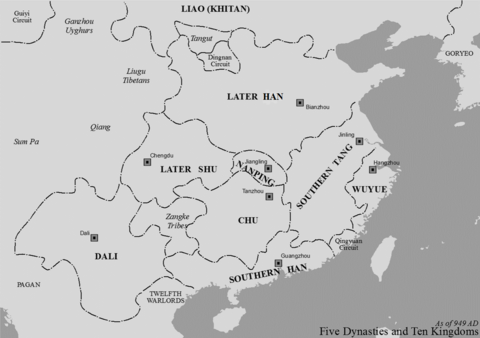
To fill the power gap, the military governor Liu Zhiyuan entered the capital in 947. He announced the start of the Later Han dynasty. This was the third Shatuo dynasty in a row. It was the shortest of the five dynasties.
After a sudden change in power in 951, General Guo Wei, who was Han Chinese, became emperor. This started the Later Zhou dynasty. However, Liu Chong, a member of the Later Han royal family, started a rival Northern Han state in Taiyuan. He asked the Khitans for help to defeat the Later Zhou.
Later Zhou (951–960)
After Guo Wei died in 954, his adopted son Chai Rong became emperor. He started a plan to expand and reunite China. One month after Chai Rong took the throne, Liu Chong, the emperor of Northern Han, teamed up with the Liao dynasty to attack Later Zhou.
Chai Rong decided to lead his army against them. He risked his life in battle and defeated Liu's forces. After this victory, Chai Rong became very powerful. Between 956 and 958, Later Zhou forces conquered much of Southern Tang. This was the strongest state in southern China. Southern Tang had to give up all its land north of the Yangtze River. In 959, Chai Rong attacked the Liao to get back land that was given away earlier. He won many battles but then got sick.
In 960, the general Zhao Kuangyin took power in a sudden move. He became emperor and founded the Northern Song dynasty. This is seen as the official end of the Five Dynasties and Ten Kingdoms period. Over the next twenty years, Zhao Kuangyin and his successor defeated the other states in southern China. They conquered Northern Han in 979, officially starting the Song dynasty era in 982.
The Ten Kingdoms

Unlike the dynasties in northern China, which changed very quickly, the states in South China usually existed at the same time. Each controlled a specific area. These were known as "The Ten Kingdoms." Some of them even claimed to have their own emperors.
Each royal court was a center for amazing art. This period is known for its lively poetry and strong economy. Trade grew so fast that there wasn't enough metal money. To help with this, people started using bank drafts, called "flying money" (feiqian). They also used certificates of deposit. Wood block printing became common during this time, 500 years before Johannes Gutenberg's printing press.
The Ten Kingdoms were:
- Yang Wu (907–937)
- Wuyue (907–978)
- Min (909–945)
- Ma Chu (907–951)
- Southern Han (917–971)
- Former Shu (907–925)
- Later Shu (934–965)
- Jingnan (924–963)
- Southern Tang (937–976)
- Northern Han (951–979)
Only ten are traditionally listed, which gives the era its name. Some historians count eleven, including Yan and Qi. They don't count the Northern Han, seeing it as just a continuation of Later Han. This era also happened at the same time as the founding of the Liao dynasty in the north.
Yang Wu
The Yang Wu kingdom (902–937) was in what is now Jiangsu, Anhui, and Jiangxi. It was founded by Yang Xingmi, who became a military governor in 892. The capital was first at Guangling (today's Yangzhou). It later moved to Jinling (today's Nanjing). The kingdom fell in 937 when the founder of the Southern Tang took it over from within.
Wuyue
The Wuyue kingdom was the longest-lasting (907–978) and one of the strongest southern states. Wuyue was known for its learning and culture. It was founded by Qian Liu, who set up his capital at Xifu (modern-day Hangzhou). It was mostly in modern Zhejiang province. Qian Liu was named the Prince of Yue by the Tang emperor in 902. After the Tang dynasty fell in 907, he declared himself king of Wuyue. Wuyue lasted until the Song dynasty took it over in 978.
Min
The Min (909–945) was founded by Wang Shenzhi. He called himself the Prince of Min, and its capital was at Changle (modern-day Fuzhou). One of Shenzhi's sons declared an independent state called Yin. The Southern Tang took that land after Min asked for help. The Southern Tang finished conquering Min in 945.
Southern Han
The Southern Han (917–971) was founded in Guangzhou by Liu Yan. His brother, Liu Yin, was named a regional governor by the Tang court. The kingdom included Guangdong, Guangxi, and Hainan. The Song dynasty finally conquered it.
Ma Chu
The Ma Chu (927–951) was founded by Ma Yin. Its capital was at Changsha. The kingdom held Hunan and parts of Guangxi. Ma was named a military governor by the Tang court in 896. He called himself the Prince of Chu when the Tang fell in 907. This title was confirmed by the Southern Tang in 927. The Southern Tang took over the state in 951. Later, in 963, the Song dynasty took over the region.
Northern Han
Even though it's one of the ten kingdoms, the Northern Han was based in the Shatuo area of Shanxi. It was founded by Liu Min after the Later Han fell to the Han Chinese-led Later Zhou in 951. With protection from the powerful Liao dynasty, the Northern Han stayed independent. But the Song dynasty finally conquered it in 979.
Jingnan (also known as Nanping)
The smallest of the southern states was Jingnan (924–963). It was founded by Gao Jichang, a former general. It was based in Jiangling and held two other areas in Hubei. Gao worked for the Later Liang. Gao's followers claimed the title of King of Nanping after the Later Liang fell in 924. It was a small and weak kingdom. It tried to stay on good terms with all the Five Dynasties. The kingdom fell to the Song armies in 963.
Former Shu
Former Shu (907–925) was founded after the Tang dynasty fell. It was started by Wang Jian, who ruled from Chengdu. The kingdom held most of modern-day Sichuan. Wang was named military governor of western Sichuan by the Tang court in 891. The kingdom fell when his son surrendered to the Later Tang in 925.
Later Shu
The Later Shu (935–965) was basically a new version of the earlier Shu state. That state had fallen ten years before to the Later Tang. Because the Later Tang was getting weaker, Meng Zhixiang saw a chance to make Shu independent again. Like the Former Shu, its capital was Chengdu. It controlled mostly the same land as before. The kingdom was well-ruled until it had to surrender to Song armies in 965.
Southern Tang
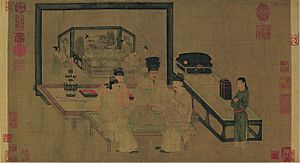
The Southern Tang (937–975) took over from the Wu kingdom. Li Bian took control of the state from within in 937. It grew from the original Wu areas. It eventually took over Yin, Min, and Chu. At its largest, it held southern Anhui, southern Jiangsu, much of Jiangxi, Hunan, and eastern Hubei. The kingdom became somewhat under the control of the growing Song dynasty in 961. It was fully taken over in 975, becoming part of the Song dynasty.
How the Ten Kingdoms Changed
Even though southern China was more stable than the north, it still had wars. Wu fought with its neighbors. This continued when Southern Tang replaced Wu. In the 940s, Min and Chu had internal problems. Southern Tang took advantage of this, destroying Min in 945 and Chu in 951.
However, parts of Min and Chu survived for many years. With these conquests, Southern Tang became the strongest state in southern China. But it couldn't defeat attacks by the Later Zhou between 956 and 958. It had to give up all its land north of the Yangtze River.
The Song dynasty, started in 960, wanted to reunite all of China. Jingnan was taken over in 963, Later Shu in 965, Southern Han in 971, and Southern Tang in 975. Finally, Wuyue gave up its land to Northern Song in 978. This brought all of southern China under the central government's control.
This period of division led to differences between northern and southern China. The greater stability of the Ten Kingdoms, especially Wuyue and Southern Han, helped create unique regional identities in China.
Culture and Art
The Five Dynasties and Ten Kingdoms period moved away from the international style of the Tang dynasty. It became a bridge towards the strong national culture of the Song dynasty. Throughout this time, there was clear cultural and economic growth, not a decline.
Several Northern dynasties came from the northeast. As the north became more centralized, important people from the provinces moved to the capital. This created a new city culture. After the Song dynasty united China, the culture, arts, and literature of the Southern states became part of the new government. The Song dynasty adopted a very Southern Chinese cultural style.
The cultural traditions of Southern Tang, Wu Yue, and Later Shu were used to rebuild the cultural landscape of the north. Southern libraries were moved north. Southern architecture was promoted in the new capital. Southern Buddhist art, monks, and relics were brought to the new capital. This helped bring these traditions into the imperial culture.
Even though it was a short period, it saw new ideas in different areas. In pottery, "white ceramics" appeared. In painting, the "varied landscape" of China was inspired by Taoism. This art showed mountains as sacred places between heaven and earth. It showed nature as a source of peace and balance.
- Art from the Five Dynasties and Ten Kingdoms period
Law and Justice
Later historians often saw the Five Dynasties as a time of unfair laws and harsh punishments. This was partly true, but it also reflects the opinions of Confucian historians. They didn't like how power was spread out and how important the military became during this time.
For example, during the Tang dynasty, executions were usually delayed until all appeals were finished. This was not common during the Five Dynasties. There were also reports of severe torture being used. The Later Han dynasty was especially known for this. Suspects could be tortured to death. Military officers in charge of security sometimes executed people without a proper investigation.
The basic law during this period was the Tang code from 737, along with other rules. The Later Liang created a new law code in 909. This code was criticized for causing delays in justice. It was also said to be too harsh for economic crimes. The Later Tang, Later Jin, and Later Zhou also updated the laws. The Later Han was in power for too short a time to make big changes to the legal system.
See Also
 In Spanish: Cinco Dinastías para niños
In Spanish: Cinco Dinastías para niños
- Timeline of the Five Dynasties and Ten Kingdoms
- Annam (Chinese province)
- Chinese sovereign
- Conquest of Southern Tang by Song
- Family trees of the emperors of the Five Dynasties
- Liao dynasty
- Dali Kingdom
- Old History of the Five Dynasties
- Zizhi Tongjian
- Tibetan Empire



